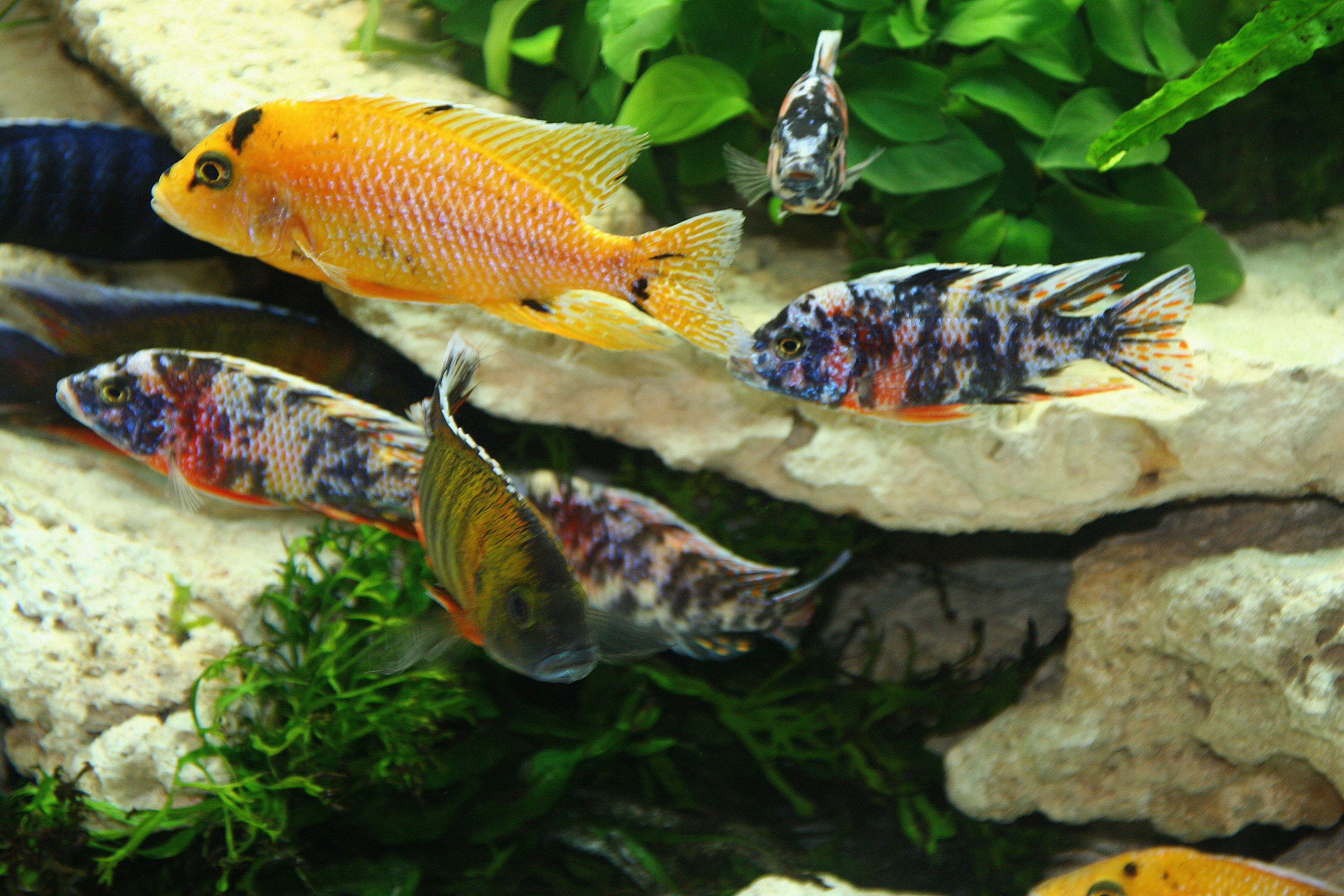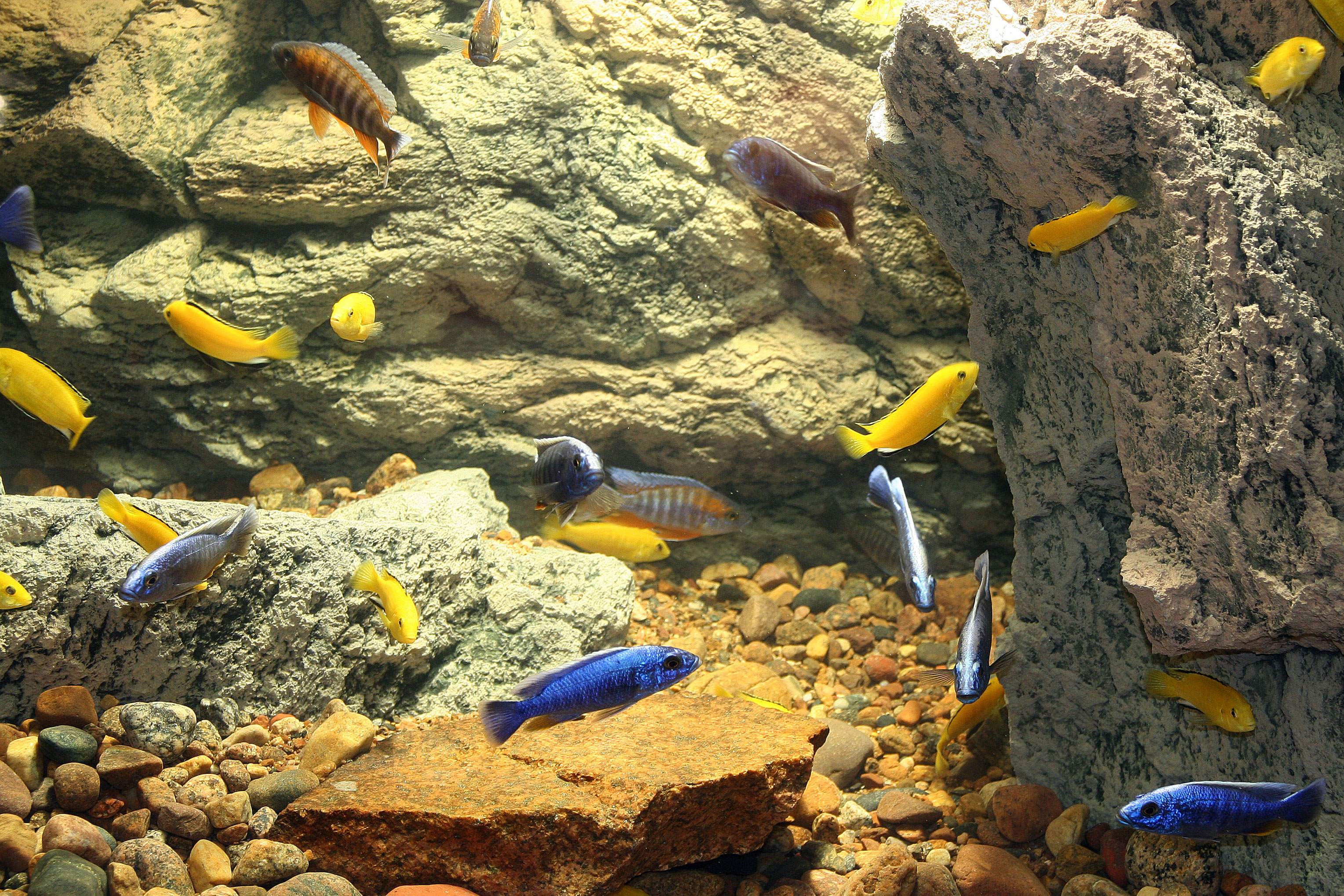Lake Malawi
As the water analysis shows, the water from Lake Malawi is relatively soft. What particularly distinguishes this water is that there is almost no dissolved CO2, and that it consequently has a high pH-value.
The experience with Malawi Cichlids has already shown, that they react less to a low pH-value than to a slowly softening water value.
Because Malawi Cichlids are typically held in relatively high densities (out of “social animal” reasons: Suppression of aggression), these pools tend to have sinking pH and CH.
When however it is not possible to act against these tendencies even when using suitable technical measures, (intensive aeration or trickle filters used to sink the CO2 content) and adequate water exchange also does not work, then there is still a third measure that can be used to influence the water value by our hardening salt mixtures.


A hardening salt is necessary also by the application of reverse osmosis water (e.g. because of unsuitable origin water, that has too much nitrate, phosphate etc.).
There is on anion side in Lake Malawi water, apart from a little chloride and almost no measurable amounts of sulfate, practically speaking only hydrogen carbonate. When one would attempt to directly simulate this water composition, then one must include heavily soluble magnesium and calcium carbonate as constituents of the hardening salt mixture.
These salts would however [for these alkaline targeted pH-values], not dissolve within an acceptable period of time.
The way out is the conception of a 2-component mixture:
Duradrakon CH-Plus for the (hydrogen) carbonates in an easily soluble form
Duradrakon TH-Plus for the associated Cations also in an easily soluble form
In this manner one can reach the desired pH-value and the desired hardness with only a slightly increased complete salt content.
Application and Dosages
The application is necessary, when one would like to introduce origin water that has a total hardness as well as carbonate hardness that lays lower than 4.5 as well as 6.5 or by intensive inhabitation with a sinking pH- and CH-value between water exchanging intervals.
With these pre-requisites we arrive at the following dosages:
| Existing Hardness [°dH CH as well as TH] |
Duradrakon CH-Plus (Carbonates - CH) |
Duradrakon TH-Plus (Alkaline Earth ions - TH) |
| 0 | 9.7 g / 50 l | 6.5 g / 50 l |
| 1 | 8.2 g / 50 l | 5.1 g / 50 l |
| 2 | 6.8 g / 50 l | 3.6 g / 50 l |
| 3 | 5.3 g / 50 l | 2.2 g / 50 l |
| 4 | 3.8 g / 50 l | 0.7 g / 50 l |
| 5 | 2.4 g / 50 l | 0.0 g / 50 l |
| 6 | 0.9 g / 50 l | … |
| > 6 | 0.0 g / 50 l | … |
In other words, one requires 1.5 g of Duradrakon CH-Plus per 50 l water in order to increase CH by 1°, as well as 1.45 g of Duradrakon TH-Plus per 50 l water in order to increase TH by 1°.
Both Mixtures must be dissolved separately from one-another and should only be mixed together directly before being added into the aquarium. This should if possible take place in a diluted form, in order to avoid the appearance of cloudy water in the form of un-dissolved calcium and magnesium carbonates.
Duradrakon CH-Plus is in its pure form relatively alkaline and so long contact with the human skin or mucus membranes (like the eyes!) should be avoided. If in doubt, flush using as much water as possible. Also please avoid breathing in the dust.
But also be careful of Duradrakon TH-Plus that can also irritate the human skin if contact occurs.
Analysis of the Lake Water
| Parameter [unit] | Value | |
| pH | 8.42 | |
| Conductivity at 25 °C [µS/cm] | 241 | |
| Acid capacity to pH 8.2 (p-Value ) [mmol/l] | 0.06 | |
| Acid capacity to pH 4.3 (m-Value ) [mmol/l] = CH [° dH] = Hydrogencarbonate, HCO3- [mg/l] |
2.35 6.6 136.0 |
|
| Sodium, Na+ [mg/l] | 19.0 | |
| Potassium, K+ [mg/l] | 6.0 | |
| Calcium, Ca2+ [mg/l] | 19.0 | |
| Magnesium, Mg2+ [mg/l] | 7.5 | |
| Sum alkaline earths (Ca + Mg) [mmol/l] = TH [° dH] |
0.79 4.4 |
|
| Complete Iron , Fe2+/3+ [mg/l] | 0.01 | |
| Manganese, Mn2+ [mg/l] | < 0.005 | |
| Aluminium, Al3+ [mg/l] | < 0.005 | |
| Ammonium, NH4+ [mg/l] | 0.05 | |
| Nitrite, NO2- [mg/l] | 0.05 | |
| Nitrate, NO3- [mg/l] | < 1.0 | |
| Chloride, Cl- [mg/l] | 5.0 | |
| Sulfate, SO42- [mg/l] | 1.0 | |
| Complete-Phosphate, PO43- [mg/l] | < 0.04 | |
| Oxidation ability as KMnO4-use [mg/l] | 1.0 | |
| Oxidation ability as oxygen-use [mg/l] | 0.3 | |
[According to “Mayland: Cichlids” see Makola Bay]
Field Report
Tilo A. cares for Malawi cichlids in water that is wonderfully suitable soft-water fish originating from the Amazon or South East Asia. TH 0.9° dH, CH 1.1° dH, conductivity 130 µS/cm . He describes his experience after a year with the usage of Duradrakon CH-Plus and Duradrakon TH-Plus in the following way:
“…has really proved itself marvellously. My Labidochromis bear the next generation in the correct relationship (more female as male). The CH and TH are perfect by 5 - 6 and 4. The salt still does not clump and makes no problems when dissolving. There is also no white colouration of the water that I have however observed when using other products.”

